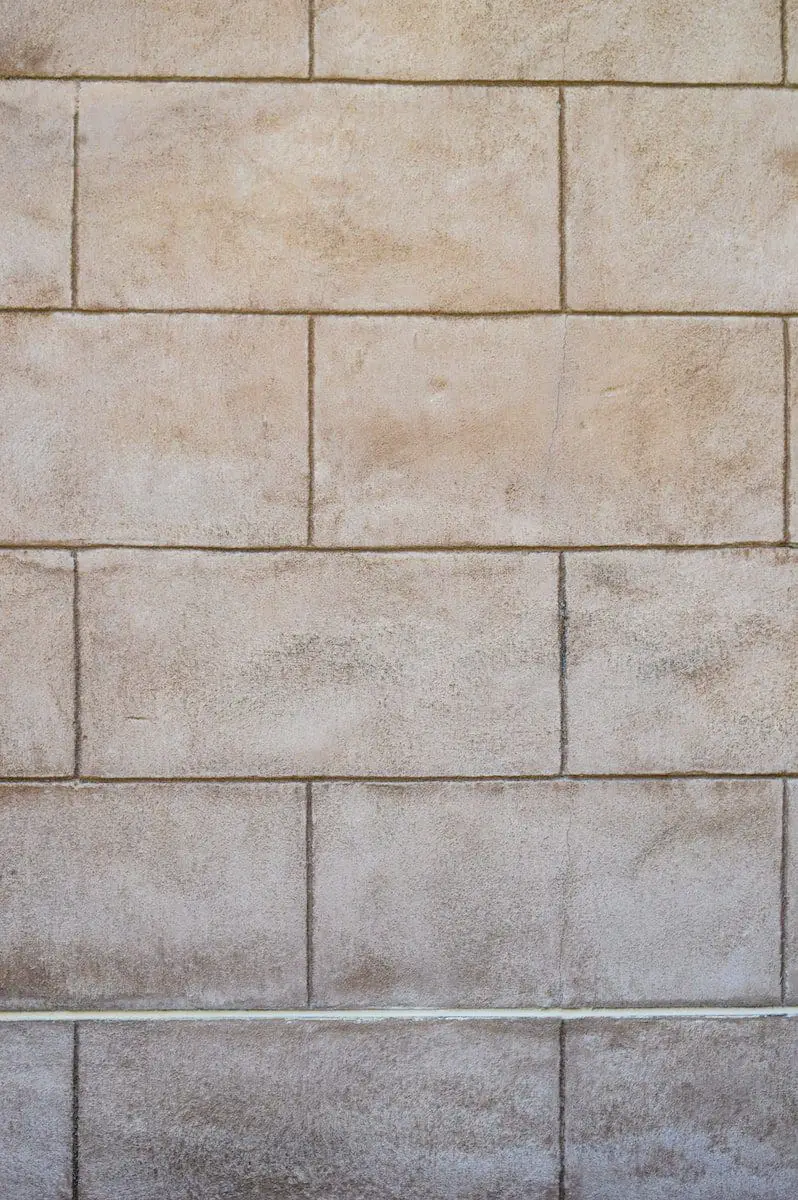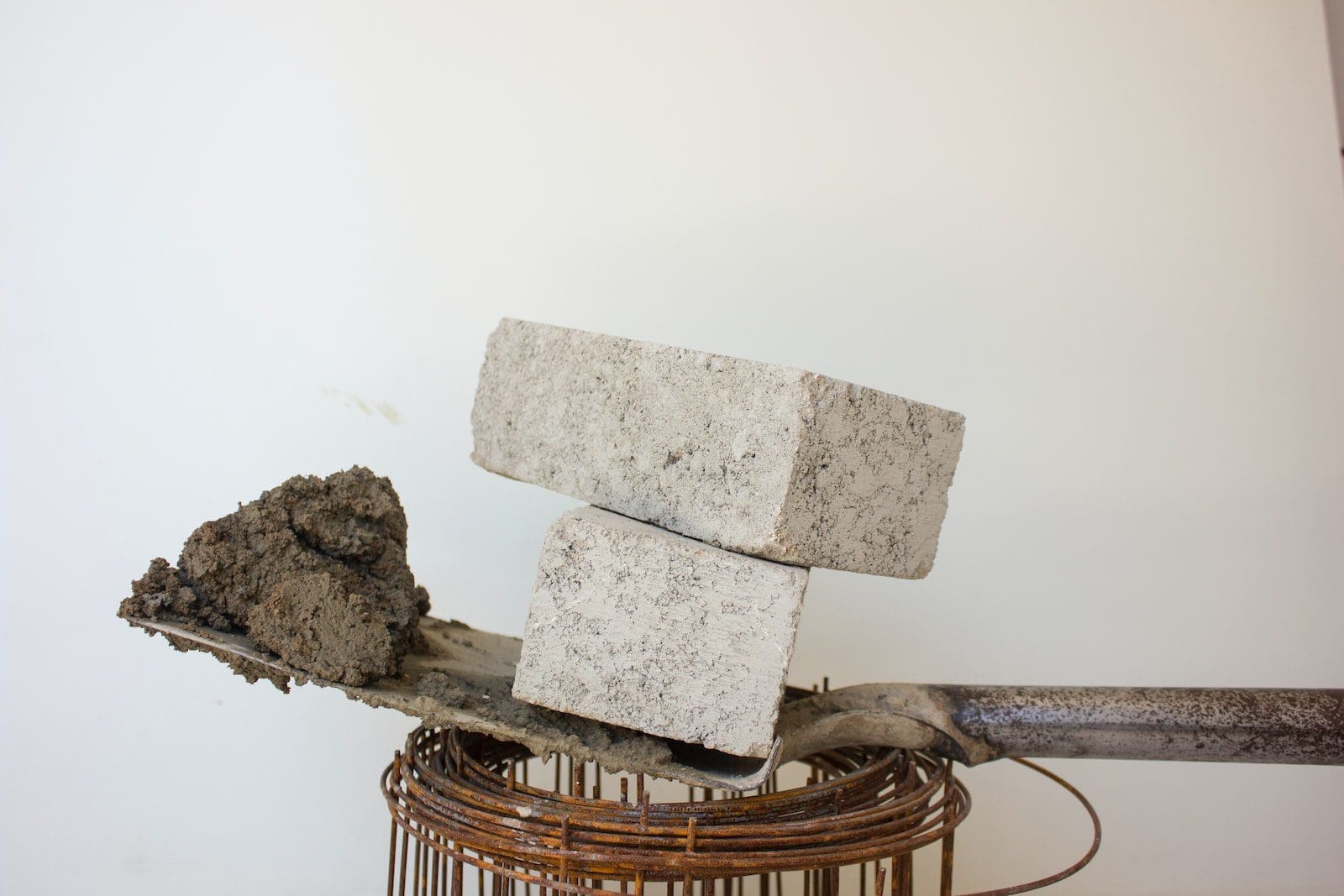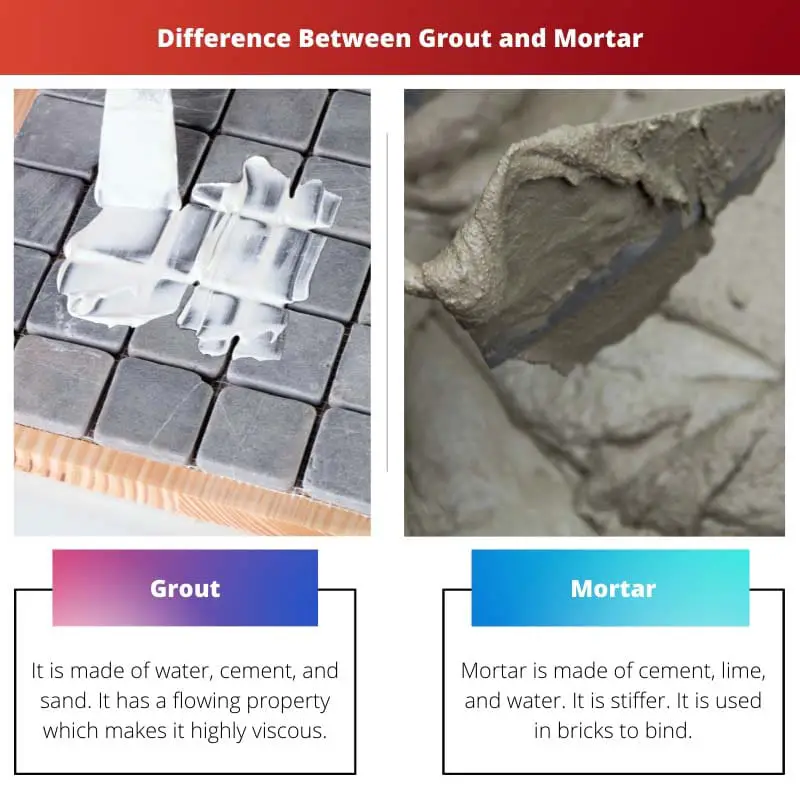Mortar and Grout are used widely in the construction industry. It differs in its properties and its applications. The water quantity differs between them, which makes them wholly different from each other.
They both contain cement in them. It differs in its physical nature. Both of them are used effectively in binding materials.
Key Takeaways
- Grout is used to filling gaps between tiles, while mortar is used to hold bricks, stones, or blocks together.
- Grout is made of cement, sand, and water, while mortar can be made of various materials such as cement, lime, or clay.
- Grout is applied after tiles are installed, while the mortar is applied during construction.
Grout vs Mortar
Grout is a type of paste that fills in the gaps between tiles to secure them in place and prevent moisture from getting underneath, available in various colors. Mortar is a mixture of sand, cement, and water used to bind bricks, stones, or concrete blocks together in construction.

Grout is made into liquid form so that it gets pumpable consistency. It is used to fill the joints. It has a water ratio in its composition high. Grout is highly viscous. It is available in different colors. It gets attached very easily and still does not loses water ration in it.
Mortar consists of pourable nature. It has a consistency like butter. The consistency is made so that it can be easily spread and gets stuck to the trowel. It sometimes contains hydrated lime. This is used to slush joints, especially collar joints. It is not used to fill the collar joints. It is available in different types.
Comparison Table
| Parameters of Comparison | Grout | Mortar |
|---|---|---|
| Water | More | Less |
| Stiff | High | Low |
| Mixture | Water, cement, sand | Water, lime, sand, cement |
| Usage | Filler | Tile bed |
| Colors | Yes | No |
| Trowel | Applied | Not applied |
What is Grout?
It is made of water, cement, and sand. It has a flowing property which makes it highly viscous. There are many options available in Grout. They are resin and epoxy.
It is used to fill the crevices of walls. It is not used as a binding agent but to fill the gaps between the walls.
This contains a lot of water in the mixture. This does not degrade the quality of the material. If the water quantity becomes high in the mixture, it may degrade the quality of the mixture.
It will decrease its adhesive nature. It is available in a variety of colors so that it can easily be used with colorful tiles.
This is not used in bricks or stones for binding them. This is also used to fill the gaps between the ceramic and stone tiles. It prevents water penetration. It can also be used in the steel industry to fill the gaps in steel materials. It is stiff. This is not applied with a trowel.
Grout sometimes contains silica sand to increase its strength so that it can be used easily to fill wider gaps. This does not include the usage of the trowel.

What is Mortar?
Mortar is made of cement, lime, and water. It is stiffer. It is used in bricks to bind. It has low viscosity, which means it cannot easily flow into gaps. It is used as a tile bed.
It makes it easily bind to the ground. It needs a very low quantity of water in its composition.
The water should be very low in the mixture; otherwise, it may degrade the quality of the Mortar. The water ratio should be less than the cement ratio in the mixture.
It contains lime to increase its durability. It is widely used in construction materials.
It gets easily attached to the trowel. It is applied between the bricks so that they can stick together for a longer time. Lime is the main difference between grout and Mortar.
It is available in different types. They are cement mortar, lime mortar, lime-cement mortar, and special mortar.
It is made into a thick paste so that it is easily used in buildings. It is especially used in between stones and bricks. It works as a binding agent. It is less stiff as compared to Mortar. It is non-porous. It is used in plastering.

Main Differences Between Grout and Mortar
- Grout has a lot of water in its composition, whereas Mortar has less water in its composition.
- Grout is less stiff as compared to Mortar.
- Grout is made of water, cement, and sand, but Mortar has water, lime, sand, and cement.
- Grout is used as filler, whereas Mortar is used as a tile bed.
- Grout is available in a variety of colors, but Mortar is available in a variety of colors.
- Grout is never used in the trowel, but Mortar is applied in the trowel.

- https://www.sciencedirect.com/science/article/pii/S0008884600002751
- https://www.sciencedirect.com/science/article/pii/S1359836803000520

The article’s detailed descriptions of grout and mortar, along with their respective properties and applications, offer a comprehensive understanding of their roles in construction and building materials.
The detailed insights into the compositions, properties, and usage of grout and mortar provide a clear distinction between these materials.
The content demonstrates a comprehensive comparison and analysis of grout and mortar, offering valuable information on their water quantity, stiffness, and applications.
This article provides comprehensive information about the composition, characteristics, and uses of grout and mortar, offering valuable insights into their distinct roles in construction and building materials.
The article’s focus on the differences and applications of grout and mortar provides a deep understanding of their significance in construction materials.
The detailed nature of the content presents a thorough examination of grout and mortar, highlighting their unique properties and applications.
This article provides detailed insights into the differences between mortar and grout, providing key takeaways and a comparison table. Grout is made of different materials such as resin and epoxy, and is used for filling gaps, while mortar is used to hold bricks, stones, or concrete blocks together, and has different types like cement mortar, lime mortar, lime-cement mortar, and special mortar.
I appreciate the comprehensive information provided in the article on the composition and applications of grout and mortar.
Great summary of the differences between grout and mortar.
The article effectively highlights the distinction between grout and mortar, with detailed descriptions of their properties and usage. It outlines that grout contains a lot of water in its composition, while mortar has less water, and also provides a useful comparison table.
The information presented here is quite detailed and focused, providing an in-depth understanding of grout and mortar.
The comparison table provided in the article effectively summarizes the differences between grout and mortar, making it easier to understand their distinct properties and applications.
The detailed comparison and explanations of grout and mortar in the article are quite informative and valuable for understanding their roles in construction.
The article’s in-depth examination of grout and mortar provides a comprehensive understanding of their compositions, properties, and usage, thereby highlighting their distinct roles in construction materials.
The detailed comparisons and explanations of grout and mortar are extremely informative, delineating their unique characteristics and functionalities.
The exhaustive information provided in the article enhances the understanding of grout and mortar, emphasizing their specific roles and applications in construction.
The article presents detailed information on the characteristics and applications of grout and mortar, providing a comprehensive understanding of their individual properties, composition, and usage in construction materials.
The comprehensive explanations of grout and mortar in the article offer valuable insights into their respective roles and functionalities in the construction industry.
The detailed exploration of grout and mortar provides an in-depth understanding of their individual properties and applications, thereby enhancing the knowledge of these construction materials.
The comparison between grout and mortar is presented clearly in the article, emphasizing their specific properties and unique applications in the construction industry.
The detailed exploration of grout and mortar makes it easier to understand their differences and suitability for various construction needs.
This article offers an informative analysis of grout and mortar, focusing on their individual compositions, applications, and properties, thereby enhancing the understanding of their distinct roles in construction.
The thorough examination of grout and mortar in the article provides valuable insights into their specific properties and suitability for different construction purposes.
The article does a great job explaining the physical nature and usage of grout and mortar. It emphasizes the role of grout in ceramic and stone tiles and the importance of mortar as a binding agent for bricks and stones.
The content is comprehensive, emphasizing the key differences between grout and mortar, including water quantity, composition, stiffness, and usage.